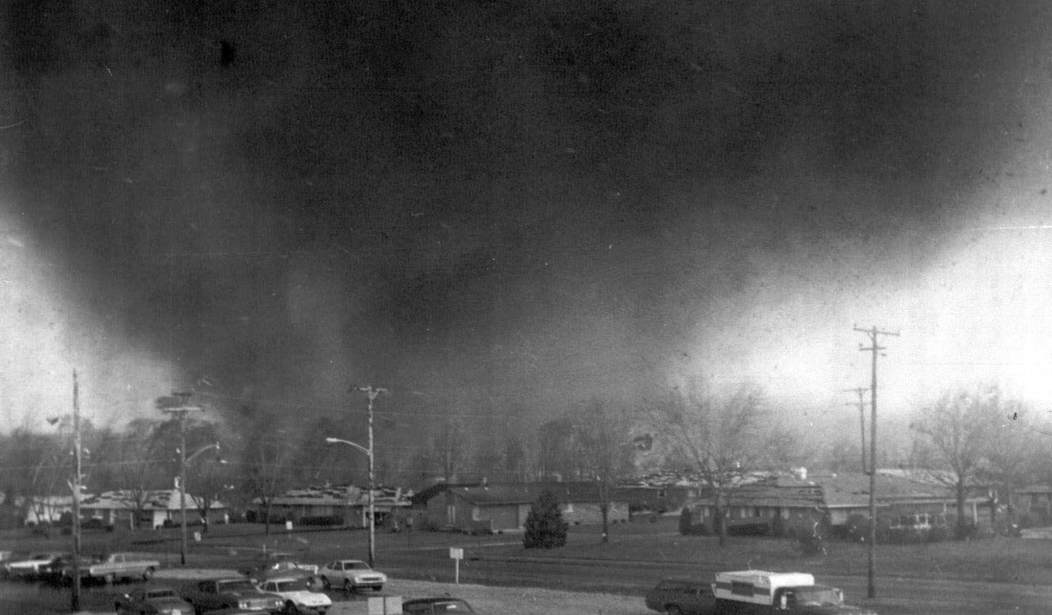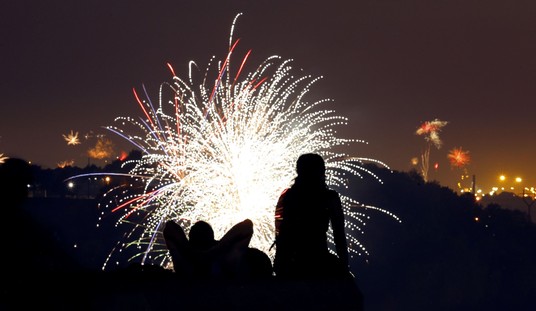The National Weather Service announced early Wednesday that a tornado had touched down in Xenia, Ohio, on Tuesday. It was the 44th anniversary of an EF5 tornado that destroyed the city, killing 34 people.
The Wilmington, Ohio, branch of the NWS confirmed touch-downs in Xenia as well as Beavercreek and Miami Township in Southwest Ohio at around 4:45 p.m. Eastern with wind speeds of 90 mph. The storm, rated at an EF1, was 200 yards wide and ran for 8.75 miles. There were no fatalities or injuries, although some residents had significant property damage and several animals were killed.
One barn had its roof blown off and another farm had “a collapsed silo with additional wall damage to another barn.” According to the NWS, “Numerous hardwood and softwood trees were damaged” and there was “roof and chimney damage” to another home. The report said the damage “was consistent with low-end EF1/high end EF0 damage, with wind estimated at 85 to 90 mph.” One home “sustained more than 30 percent of [the] roof being torn off, multiple broken windows, and structural damage to both the exterior and interior walls of the home.” That damage was consistent with wind speeds of 85 to 90 mph, the NWS said.
Unreal! On the 44th anniversary of the Xenia, Ohio tornado (super outbreak of 1974), they get hit again. From our partners with @LiveStormsMedia @KATVNews #InsideTheStorm pic.twitter.com/didO0hjKHM
— Todd Yakoubian (@KATVToddYak) April 3, 2018
Another home received “minor structural damage” as well as a collapsed chimney and a destroyed fence. In addition, “a large camper was rolled over, and the roof was lifted off a brick outbuilding.” Damage to that property was consistent with an EF1 strength of near 90 mph.
One sheep farm in the area lost five sheep.
The tornado comes on the 44th anniversary of the April 3, 1974, “Super Outbreak” of tornadoes that ravaged 13 states in the eastern United States. Ohio, Kentucky, and Indiana were hardest hit, with hundreds of deaths reported as a result of the storm.
The Dayton Daily News wrote in 2011:
On April 3, 1974 an F-5 tornado tore through the heart of Xenia, killing 33 people and injuring more than 1,300 others. It bulldozed a path more than a half-mile wide, destroying or damaging more than 1,400 buildings, including 1,200 homes, dozens of businesses, 10 churches, and several schools. By the time it lifted into the sky near Cedarville, it left behind more than $100 million of damage in Greene County.
The Xenia tornado was part of a super outbreak, when 148 twisters swept across several states, killing 335 people in a 16-hour period on April 3-4, 1974. It still ranks as one of the largest natural disasters in American history, with Xenia the hardest hit community.
The Xenia subdivision of “Arrowhead” was especially hard-hit, the tornado leaving it in ruins. The 4-year-old subdivision on the city’s southwest side lost more than 300 homes, many on concrete slabs with no basements.
Greene Memorial Hospital in northeast Xenia narrowly escaped the tornado’s wrath, but lost its power and telephone service and its water quality was suspect. About 500 people were treated there in the first 24 hours, 34 of them being admitted with a number transferred to hospitals in nearby Dayton for treatment.
The storm also destroyed Xenia High School.

(Image credit: Wilmington National Weather Service via Wikipedia)
Wikipedia described the destructiveness of that storm:
When the storm reached central Xenia at 4:40 pm, apartment buildings, homes, businesses, churches, and schools including Xenia High School were destroyed. Students in the school, practicing for a play, took cover in the main hallway seconds before the tornado dropped a school bus onto the stage where they had been practicing and extensively damaged the school building. Several railroad cars were lifted and blown over as the tornado passed over a moving Penn Central freight train in the center of town. It toppled headstones in Cherry Grove Cemetery, then moved through the length of the downtown business district, passing west of the courthouse (which sustained some exterior damage). Numerous businesses in downtown Xenia were heavily damaged or destroyed, and several people were killed at the A&W Root Beer stand as the building was flattened. Past downtown, the tornado continued into the Pinecrest Garden district, which was extensively affected.
President Richard Nixon visited Xenia shortly after the tornado, saying at the time, “As I look back over the disasters, I saw the earthquake in Anchorage in 1964; I saw the hurricanes… Hurricane Camille in 1969 down in Mississippi, and I saw Hurricane Agnes in Wilkes-Barre, Pennsylvania. And it is hard to tell the difference among them all.” He added, “I would say in terms of destruction, just total devastation, this is the worst I have seen.” He immediately declared the city a disaster area.
The Super Outbreak was the catalyst for the passage of the Federal Disaster Relief Act, which had been introduced in 1973 but at the time of the storm had not yet passed Congress.
Xenia was also hit by another tornado, this time an F-4, on September 20, 2000—twenty-six years after the storm that destroyed the city. That storm struck in early autumn, killing one man and destroying or damaging more than 300 homes and 30 businesses. It followed a similar path as the 1974 storm.
Follow me on Twitter @pbolyard










Join the conversation as a VIP Member